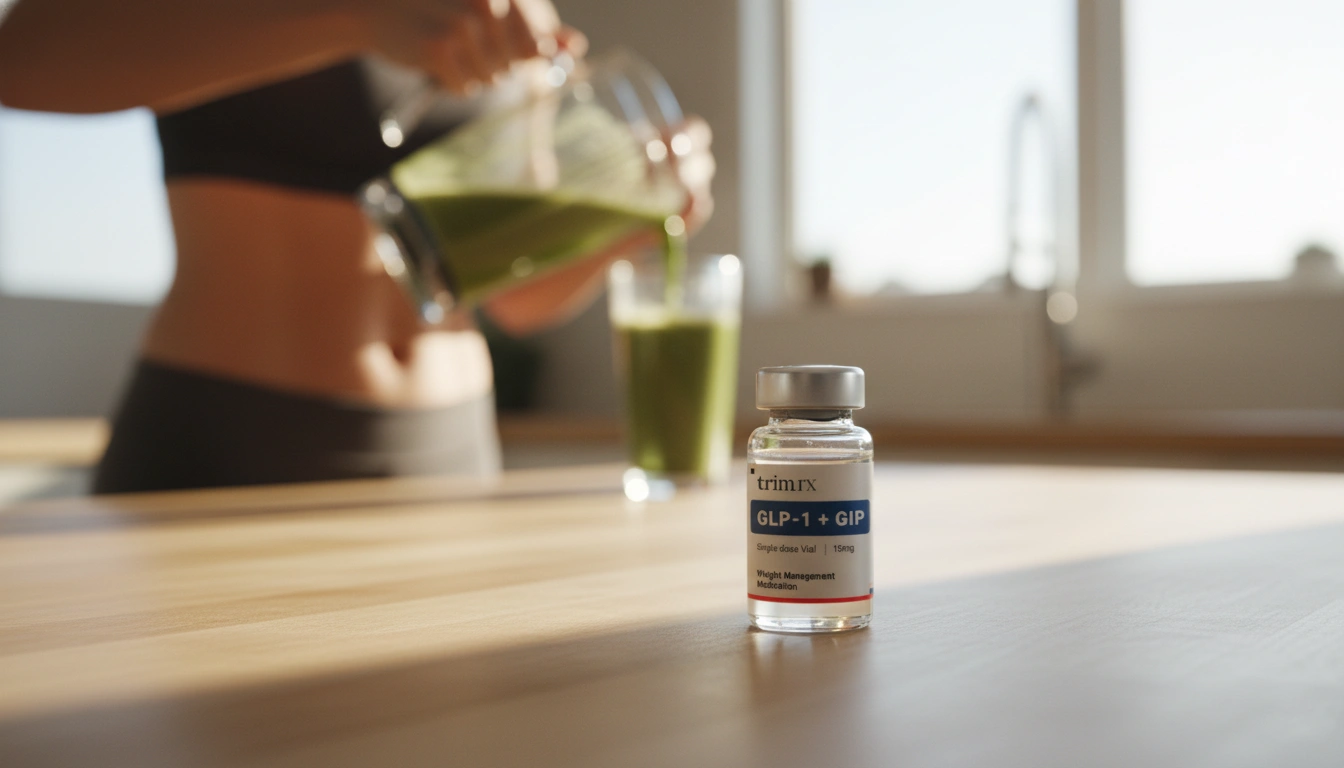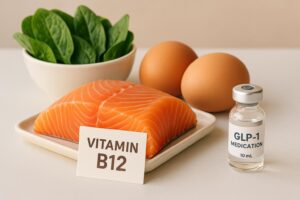What Stimulates GLP-1? Understanding the Factors That Enhance This Important Hormone

Introduction
Have you ever wondered why certain foods make you feel fuller than others? Or why some meals seem to help you manage your appetite better? The answer lies in a hormone known as glucagon-like peptide-1 (GLP-1). This remarkable peptide plays a crucial role in regulating appetite, insulin secretion, and overall metabolic health. In fact, the stimulation of GLP-1 can significantly influence weight management and metabolic disorders such as type 2 diabetes.
Research indicates that GLP-1 is secreted by the enteroendocrine L-cells in the gut in response to food intake. However, not all foods trigger the same level of GLP-1 release. Understanding what stimulates GLP-1 can empower us to make better dietary choices that support our health and wellness goals. In this blog post, we will delve into the various factors that stimulate GLP-1 release, from specific nutrients to hormonal interactions, and explore how these insights can guide us on our path to healthier living.
Throughout this article, we will cover:
- The biological role of GLP-1 and its significance in metabolic health.
- The types of nutrients that stimulate GLP-1 secretion.
- The mechanisms through which these nutrients affect GLP-1 levels.
- The potential implications of GLP-1 stimulation for weight management and diabetes prevention.
By the end of this post, you will have a comprehensive understanding of what stimulates GLP-1 and how to harness this knowledge for improved health outcomes.
Understanding GLP-1 and Its Role in Metabolic Health
Glucagon-like peptide-1 (GLP-1) is a hormone that plays a key role in glucose metabolism and appetite regulation. It is produced in the intestinal L-cells and released into the bloodstream following food intake. Here’s a closer look at its functions:
The Functions of GLP-1
-
Insulin Secretion: GLP-1 enhances glucose-dependent insulin secretion from the pancreatic beta-cells, thereby helping to lower blood sugar levels after eating.
-
Inhibition of Glucagon: It suppresses the release of glucagon, a hormone that raises blood sugar levels, thus contributing to overall glucose homeostasis.
-
Slowing Gastric Emptying: GLP-1 slows down gastric emptying, which helps prolong the feeling of fullness and reduces appetite.
-
Promoting Satiety: The hormone acts on the brain to promote a feeling of fullness, helping to regulate food intake.
-
Beta-Cell Preservation: GLP-1 has been shown to protect pancreatic beta-cells from apoptosis, contributing to better insulin production over time.
Given its multifaceted role, GLP-1 has become a target for therapeutic interventions in obesity and diabetes management.
Nutritional Factors That Stimulate GLP-1
The secretion of GLP-1 is predominantly stimulated by the ingestion of food. However, not all foods have the same effect. Here are the key nutrients that have been shown to increase GLP-1 levels:
1. Proteins and Amino Acids
Protein-rich foods are potent stimulators of GLP-1 secretion. Studies show that meals high in protein lead to substantially higher GLP-1 levels compared to carbohydrate-rich meals. Specific amino acids, such as l-valine, have been identified as particularly effective in stimulating GLP-1 release.
-
Mechanism: When proteins are digested, they release amino acids and peptides, which are sensed by L-cells in the gut. This signaling leads to the secretion of GLP-1.
-
Research Insight: A recent study demonstrated that the presence of l-valine in the gastrointestinal tract led to a significant increase in GLP-1 levels in rodent models, suggesting its potential as a dietary supplement for enhancing GLP-1 secretion.
2. Fats
Dietary fats, especially unsaturated fats, have also been shown to stimulate GLP-1 release. Foods like avocados, nuts, and olive oil are examples of healthy fats that can promote GLP-1 secretion.
-
Mechanism: Long-chain fatty acids activate specific G-protein coupled receptors (GPCRs) in the L-cells, leading to increased GLP-1 secretion.
-
Research Insight: Studies suggest that meals high in monounsaturated fats, such as those found in olive oil, lead to a more significant GLP-1 response compared to saturated fats like butter.
3. Fiber
High-fiber foods such as whole grains, fruits, and vegetables are essential for stimulating GLP-1 secretion. Fiber is fermented in the gut to produce short-chain fatty acids (SCFAs), which have been linked to increased GLP-1 levels.
-
Mechanism: SCFAs stimulate GLP-1 secretion by binding to specific receptors on L-cells, promoting the release of this important hormone.
-
Research Insight: Increased dietary fiber intake has been associated with improved GLP-1 response, suggesting that fiber-rich diets can play a role in weight management and metabolic health.
4. Carbohydrates
While carbohydrates generally stimulate GLP-1 secretion, they do so indirectly. Foods high in complex carbohydrates, such as legumes and whole grains, can promote a steadier release of glucose, which subsequently stimulates GLP-1.
-
Mechanism: The gradual release of glucose into the bloodstream helps to enhance GLP-1 secretion, offering a more sustained effect on appetite regulation.
-
Research Insight: Studies indicate that the glycemic index of carbohydrates can affect GLP-1 levels, with lower-glycemic foods resulting in a more favorable GLP-1 response.
Other Factors Influencing GLP-1 Release
In addition to dietary components, several other factors can influence GLP-1 secretion:
1. Hormonal Interactions
Hormones such as glucose-dependent insulinotropic polypeptide (GIP) and leptin can enhance GLP-1 secretion. For instance, GIP is released in response to nutrient ingestion and can act synergistically with GLP-1 to regulate insulin secretion.
2. Gut Microbiota
Emerging research has highlighted the role of gut microbiota in the modulation of GLP-1 secretion. The fermentation of dietary fibers by gut bacteria produces SCFAs, which can stimulate GLP-1 release. A diverse and healthy gut microbiome is essential for optimizing GLP-1 levels.
3. Physical Activity
Regular physical activity has been shown to improve GLP-1 secretion and insulin sensitivity. Exercise can enhance the body’s metabolic response to food, leading to increased GLP-1 levels.
Implications for Weight Management and Diabetes Prevention
Understanding what stimulates GLP-1 has important implications for weight management and diabetes prevention. By focusing on a diet rich in proteins, healthy fats, and fiber, we can naturally enhance GLP-1 secretion, leading to better appetite control and improved metabolic health.
The TrimRx Approach
At TrimRx, we believe in a personalized approach to weight loss that incorporates scientifically backed strategies for enhancing GLP-1 levels. Our programs are designed to provide you with the tools and support needed to make sustainable lifestyle changes that promote healthier eating and improved metabolic function.
If you’re looking to explore how our personalized weight loss solutions can help you on your journey, we invite you to take our free assessment quiz to see if you qualify for our prescription weight loss medications. Together, we can work towards achieving your health goals.
Conclusion
GLP-1 is a vital hormone that plays a significant role in regulating appetite and glucose metabolism. By understanding what stimulates GLP-1 secretion, we can make informed dietary choices that support our health and wellness goals.
Incorporating protein-rich foods, healthy fats, and fiber into our diets can enhance GLP-1 levels and contribute to effective weight management and diabetes prevention. As we continue to learn more about the factors influencing GLP-1, we can develop strategies that empower us to take control of our health.
FAQ
What is GLP-1 and why is it important?
GLP-1 is a hormone released from the gut that helps regulate blood sugar levels and appetite. It enhances insulin secretion, slows gastric emptying, and promotes feelings of fullness.
How can I increase my GLP-1 levels through diet?
Incorporating protein-rich foods, healthy fats, and high-fiber foods into your diet can help stimulate GLP-1 secretion.
Are there any supplements that can help with GLP-1 secretion?
Certain amino acids and dietary fibers may help enhance GLP-1 levels when included in a balanced diet. It’s best to consult with a healthcare provider for personalized recommendations.
How does TrimRx support weight loss?
TrimRx offers personalized, medically supervised weight loss programs that combine dietary strategies, lifestyle changes, and prescription medications to help individuals achieve sustainable results.
Can physical activity influence GLP-1 levels?
Yes, regular physical activity can improve GLP-1 secretion and enhance insulin sensitivity, contributing to better metabolic health.
By making informed dietary choices and understanding the factors that stimulate GLP-1, we can take proactive steps towards better health and well-being. For further support on your journey, consider taking our free assessment quiz to explore our personalized weight loss solutions. Together, we’ll work towards achieving your goals!

Transforming Lives, One Step at a Time
Keep reading
Vitamin B12 and GLP-1 Medications: What to Know
GLP-1 medications can lower B12 absorption and intake; learn symptoms, food sources, supplement options, and how to monitor levels.
Semaglutide Injection Site Reactions: What To Know
Learn why semaglutide injections can cause redness, swelling or nodules, how to prevent and treat them, and when to seek medical care.
TrimRx vs Friday’s
Compare TrimRx and Friday’s telehealth GLP-1 weight-loss programs: pricing, medical support, coaching, delivery, and which fits your needs.



